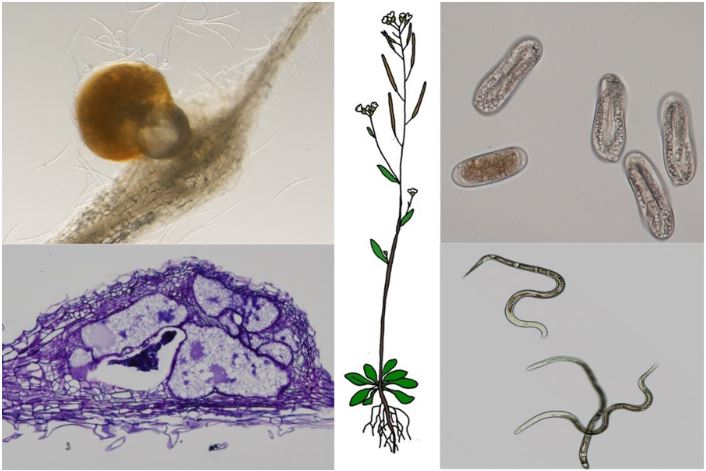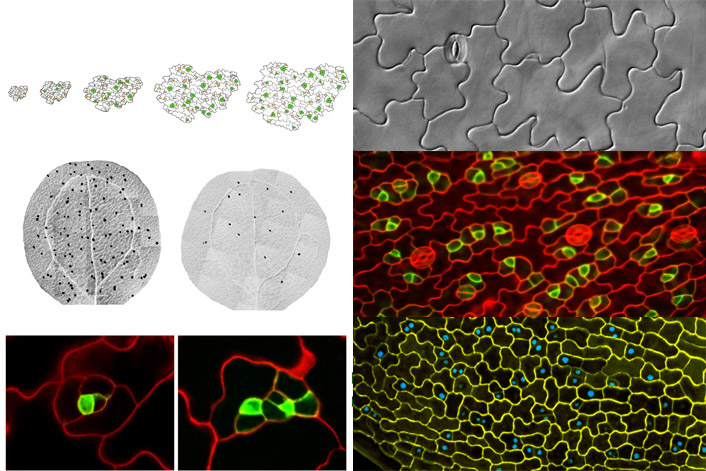The research line of the group is centered in the study of the molecular basis of the interaction between endoparasitic nematodes and plants. The central objective is to understand molecular mechanisms of gene reprogramming that allow the development of feeding sites induced by the nematodes from root cells not yet determined. Those are root swellings called galls that contain several nourishing cells called giant cells. We combined molecular biology cell biology, transcriptomic approaches and bioinformatics.
Our first approaches were based on promoters activated in nematode feeding sites, among them the most relevant, those form the Geminivirus (Maize streak virus) and small heat-shock proteins. This was followed by holistic approaches to study specifically the giant cells formed by root-knot nematodes in Arabidopsis and tomato by combining transcriptomics to cell biology techniques, such as laser microdissection. A wide number of differentially expressed genes in giant cells as compared to vascular cells from non-infected tissues were identified what includes miRNAs which functions are being explored.

Another basic objective is to identify the cell types that the nematode reprogram to form the galls and giant cells. The nematodes alter developmental patterns already stablished in plants to induce those nourishing cells. Hence, we are comparing several routes and mechanisms of development-differentiation in the roots with that of galls/giant cells development. We started identifying a crucial transducer for gall development that is also central for the development of lateral roots and belongs to the lateral organ boundaries family of transcription factors, LBD16.
The final objective is to investigate nematode-control strategies based on plant-biotechnology that also could allow the combination to other methods, such as biopesticides for the integrated management, all in the context of sustainable agronomical systems. There is an urgent need to develop those methods because the agrochemicals are progressively banishing due to their toxicity and natural resistance is not an effective option any longer as its durability is being questioned.
The aerial epidermis of terrestrial plants is covered by a bioplastic cuticle largely impermeable to gases such as water vapor or CO2. This protects the plant from excessive water loss and thence desiccation, but also impedes taking up CO2 and thence photosynthesis. Regulated gas exchange between the plant and the atmosphere takes place through special structures called stomata. These are microscopic valves made by two guard cells that delimit a stomatal pore. Shape changes in guard cells open or close the pore, allowing a precise adjustment of gas fluxes and regulating photosynthesis and also transpiration –and therefore cooling of the plant. Stomata operate within relatively narrow margins set for their optimal function and are rarely wide open. For this reason, their abundance and also their distribution patterns are essential for determining the maximum area available for gas exchange, thus impinging on plant survival and reproduction.

The formation of stomata in Arabidopsis is accompanied by a series of stereotyped cell divisions where many of the resulting cells become pavement cells. At the end of this process the majority of all pavement cells in a leaf derive from these stomata lineages and are developmentally related to the stomata. So, studying stomata formation is also studying epidermal development. Among the many proteins know to regulate this developmental process are three related transcription factors of the basic-Helix-loop-Helix (bHLH) superfamily, SPEECHLESS (SPCH), MUTE and FAMA, which consecutively drive cell division and differentiation events from stomatal lineage initiation to stoma formation. We are interested in the genetic and molecular control of these cell division and fate acquisition processes, using as a model Arabidopsis thaliana, and combining direct and reverse genetics with transcriptomics and cell and developmental biology, exploiting induced mutants, transgenic lines and natural genetic variants in the three stomatal bHLHs. In collaboration with other groups, we also study the physiological differences of alleles of these stomatal genes that determine different stomatal numbers.
As stomatal abundance is crucial for crop productivity and performance, particularly in the Climate Change scenario, we are translating our research to crops like tomato and grapevine, finding functional orthologues of Arabidopsis stomatal genes and studying the anatomical and physiological consequences of mutations in these genes. In collaboration with breeding experts we plan to introduce useful variants in breeding programs aimed at obtaining better water use efficiency under drought conditions (low-stomata varieties), or sustained productivity at high temperatures under irrigation (high-stomata varieties).